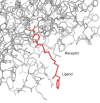Automated site preparation in physics-based rescoring of receptor ligand complexes
- PMID: 19382204
- PMCID: PMC2744578
- DOI: 10.1002/prot.22415
Automated site preparation in physics-based rescoring of receptor ligand complexes
Abstract
Hydrogen atoms are not typically observable in X-ray crystal structures, but inferring their locations is often important in structure-based drug design. In addition, protonation states of the protein can change in response to ligand binding, as can the orientations of OH groups, a subtle form of "induced fit." We implement and evaluate an automated procedure for optimizing polar hydrogens in protein-binding sites in complex with ligands. Specifically, we apply the previously described Independent Cluster Decomposition Algorithm (ICDA) algorithm (Li et al., Proteins 2007;66:824-837), which assigns the ionization states of titratable residues, the amide orientations of Asn/Gln side chains, the imidazole ring orientation in His, and the orientations of OH/SH groups, in a unified algorithm. We test the utility of this method for identifying nativelike ligand poses using 247 protein-ligand complexes from an established database of docked decoys. Pose selection is performed with a physics-based scoring function based on a molecular mechanics energy function and a Generalized Born implicit solvent model. The use of the ICDA receptor preparation protocol, implemented with no knowledge of the native ligand pose, increases the accuracy of pose selection significantly, with the average RMSD over all complexes decreasing from 2.7 to 1.5 A when applying ICDA. Large improvements are seen for specific classes of binding sites with titratable groups, such as aspartyl proteases.
Figures



Similar articles
-
Assignment of polar states for protein amino acid residues using an interaction cluster decomposition algorithm and its application to high resolution protein structure modeling.Proteins. 2007 Mar 1;66(4):824-37. doi: 10.1002/prot.21125. Proteins. 2007. PMID: 17154422
-
Postprocessing of docked protein-ligand complexes using implicit solvation models.J Chem Inf Model. 2011 Feb 28;51(2):267-82. doi: 10.1021/ci100354x. Epub 2011 Feb 10. J Chem Inf Model. 2011. PMID: 21309544
-
Asparagine and glutamine: using hydrogen atom contacts in the choice of side-chain amide orientation.J Mol Biol. 1999 Jan 29;285(4):1735-47. doi: 10.1006/jmbi.1998.2401. J Mol Biol. 1999. PMID: 9917408
-
Comparing protein-ligand docking programs is difficult.Proteins. 2005 Aug 15;60(3):325-32. doi: 10.1002/prot.20497. Proteins. 2005. PMID: 15937897 Review.
-
Neutron Crystallography for the Study of Hydrogen Bonds in Macromolecules.Molecules. 2017 Apr 7;22(4):596. doi: 10.3390/molecules22040596. Molecules. 2017. PMID: 28387738 Free PMC article. Review.
Cited by
-
The Discovery of Potent SHP2 Inhibitors with Anti-Proliferative Activity in Breast Cancer Cell Lines.Int J Mol Sci. 2022 Apr 18;23(8):4468. doi: 10.3390/ijms23084468. Int J Mol Sci. 2022. PMID: 35457286 Free PMC article.
-
Biased retrieval of chemical series in receptor-based virtual screening.J Comput Aided Mol Des. 2010 Dec;24(12):1053-62. doi: 10.1007/s10822-010-9394-9. Epub 2010 Oct 30. J Comput Aided Mol Des. 2010. PMID: 21053053
-
Computational methods in drug discovery.Beilstein J Org Chem. 2016 Dec 12;12:2694-2718. doi: 10.3762/bjoc.12.267. eCollection 2016. Beilstein J Org Chem. 2016. PMID: 28144341 Free PMC article. Review.
-
Active site detection by spatial conformity and electrostatic analysis--unravelling a proteolytic function in shrimp alkaline phosphatase.PLoS One. 2011;6(12):e28470. doi: 10.1371/journal.pone.0028470. Epub 2011 Dec 8. PLoS One. 2011. PMID: 22174814 Free PMC article.
-
Life beyond kinases: structure-based discovery of sorafenib as nanomolar antagonist of 5-HT receptors.J Med Chem. 2012 Jun 28;55(12):5749-59. doi: 10.1021/jm300338m. Epub 2012 Jun 19. J Med Chem. 2012. PMID: 22694093 Free PMC article.
References
-
- Chen H, Lyne PD, Giordanetto P, Lovell T, Li J. On Evaluating Molecular-Docking Methods for Pose Prediction and Enrichment Factors. J Chem Inf Model. 2006;46(1):401–415. - PubMed
-
- Carlsson J, Boukharta L, Aqvist J. Combining docking, molecular dynamics and the linear interaction energy method to predict binding modes and affinities for non-nucleoside inhibitors to HIV-1 reverse transcriptase. J Med Chem. 2008;51(9):2648–2656. - PubMed
-
- Enyedy IJ, Egan WJ. Can we use docking and scoring for hit-to-lead optimization? J Comput Aided Mol Des. 2008;22:161–168. - PubMed
-
- Friesner RA, Murphy RB, Repasky MP, Frye LL, Greenwood JR, Halgren TA, Sanschagrin PC, Mainz DT. Extra Precision Glide: Docking and Scoring Incorporating a Model of Hydrophobic Enclosure for Protein-Ligand Complexes. J Med Chem. 2006;49(21):6177–6196. - PubMed
-
- Kolb P, Huang D, Dey F, Caflisch A. Discovery of kinase inhibitors by high-throughput docking and scoring based on a transferable linear interaction energy model. J Med Chem. 2008;51(5):1179–1188. - PubMed
Publication types
MeSH terms
Substances
Grants and funding
LinkOut - more resources
Full Text Sources

